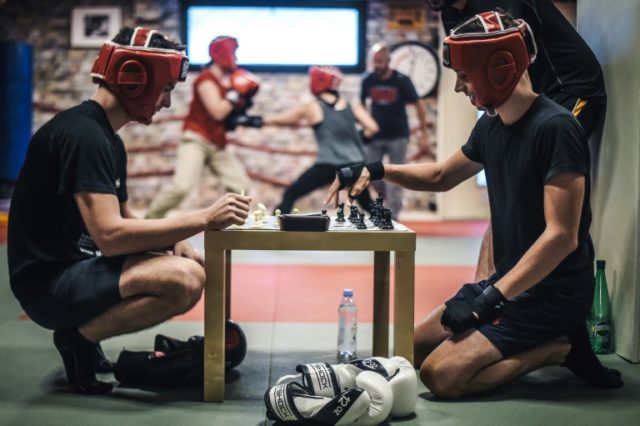Paris (AFP) – Dripping with sweat, gasping for breath and desperately trying to refocus after fending off hooks and throwing uppercuts, Nikopol warily moves his bishop across the chessboard…
Once the literary creation of French artist Enki Bilal’s illustrated books, chessboxing is now a reality, a mix of chess and boxing played out in flesh and, occasionally, blood across the world.
It combines the physical and the intellectual — and is growing in popularity.
The sport, which makes its first fightnight appearance in the ring in France in November, has grown out of Nikopol’s adventures in Bilal’s 1992 book “Cold Equator”, the final chapter in an epic trilogy in which the hero triumphs in a combat combining the strength of boxing and the intelligence of chess.
“At one point, I wanted my characters to confront each other in a spectacular way, in a gladiatorial way, just as sport does,” Bilal told AFP.
“I wanted to find a sport that would epitomise the very essence of excellence in a human being, namely his supreme intelligence and his strength.”
“What hit me straight away was chess. And boxing is important because it has a nobility. Behind the violence there is a whole philosophy of movement, of space. I immediately imagined them in a ring.”
Ten years after Nikopol climbed through the ropes, Dutch performance artist Iepe Rubingh took the sport off the page and stuck it into a real ring.
In 2003, he organised the first fight — of which he was one of the two protagonists — and created the World Chess Boxing Organisation (WCBO) before promoting bouts around the world via the Intellectual Fight Club (IFC).
– Breaking stereotypes –
Today, there are 10 national federations and around 3,500 combatants, mainly in Germany, Britain and India and almost entirely men.
“It’s the most complete sport,” says Thomas Cazeneuve, a recruitment consultant who became France’s first world champion in 2017.
“We work the body and the mind. It breaks the stereotypes, like that of the fighter who is a brute and that of the chess player who is a ‘geek’, not at all sporty, top of his class who will go on to be a computer expert.”
The rules are straightforward enough. A contest breaks down into 11 rounds — six rounds of chess interspersed with five rounds of boxing. If it goes the distance, a match usually lasts around 45 minutes.
The chess is played under time controlled ‘blitz’ regulations with the fighters stripped to the waist and wearing a soundproofing helmet to cut out the noise of the crowd who bay and holler at every move on the board.
Cazeneuve grew up on chess as a kid before taking up kickboxing as a teenager. Now he has found the perfect outlet to blend his twin sports.
“You have to be able to switch from boxing to chess while remaining lucid so that the level of chess does not go down,” he explains.
“We are used to playing chess in a room without noise, with a bottle of water, a bite to eat.
“But here we bleed, we hurt, we are out of breath, we don’t know where we live and we have to play.”
A victory, usually by knockout in the ring or checkmate on the board, wins and ends the entire contest. It is very rare that the decision has to go to the judges.
“It is a duel, no one gives an inch,” says French federation president Guillaume Salancon who likens chessboxing to bullfighting.
“It’s a performance where you know something will happen, an artistic performance. It’s completely mystical, powerful, moving, something you don’t always have in sport.”
And with skateboarding and break dancing being welcomed into the Olympic fold, is it too fanciful to imagine chessboxing taking off at Paris 2024 or Los Angeles 2028?
Nikopol and his creator Enki Bilal would certainly approve.

COMMENTS
Please let us know if you're having issues with commenting.